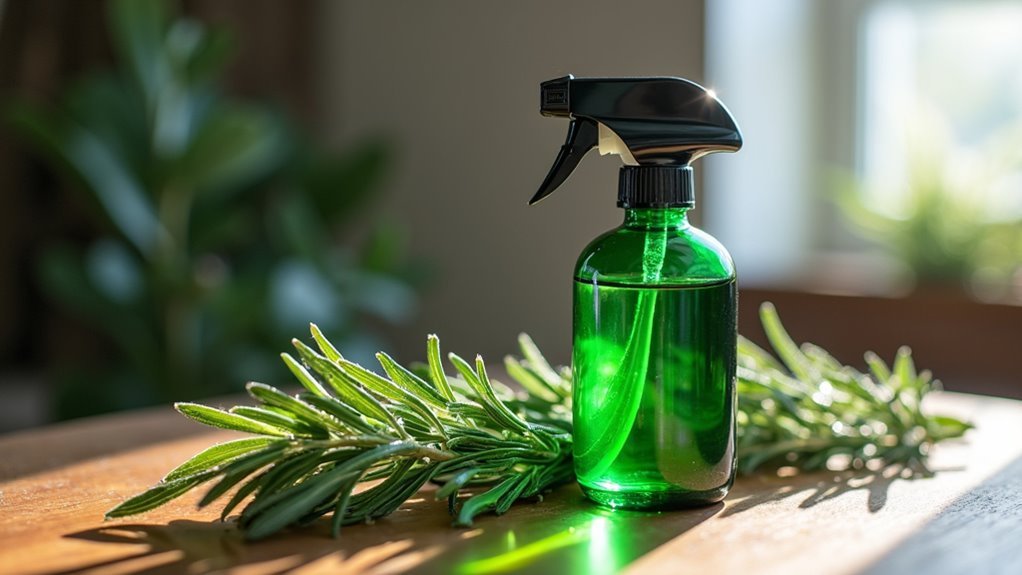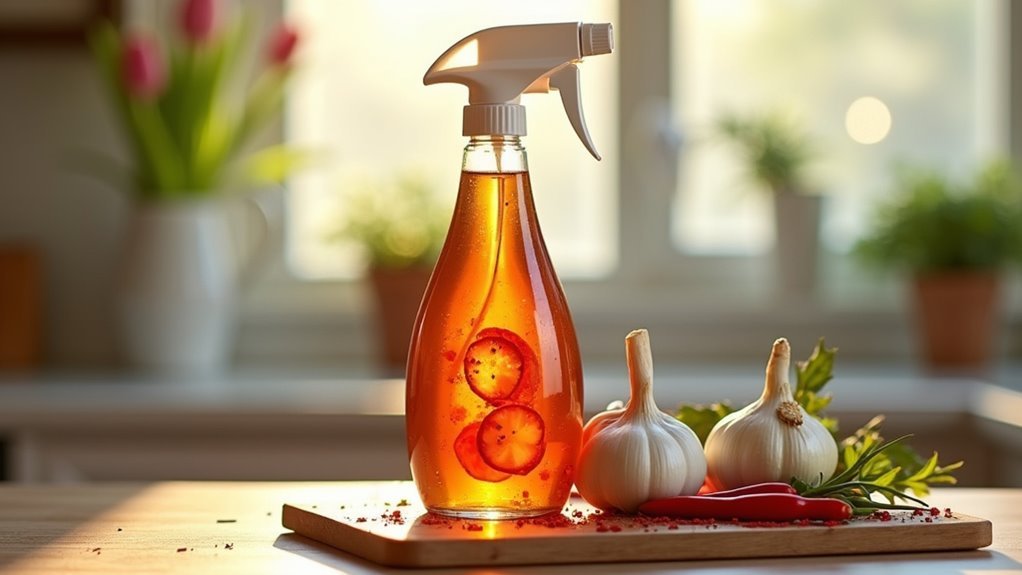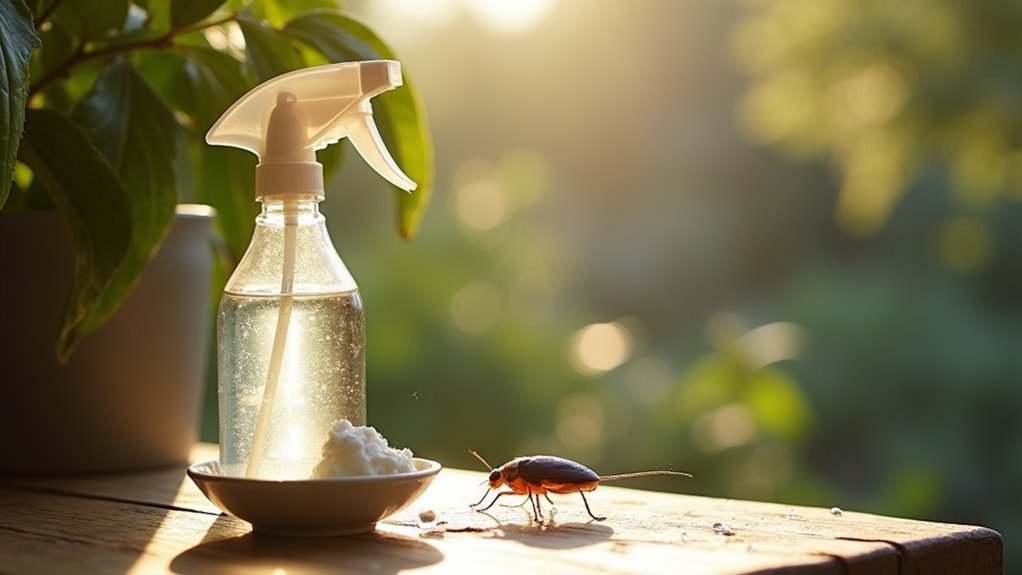You can create effective homemade roach sprays using common household ingredients that achieve impressive results. Mix rosemary and eucalyptus oils with water for up to 100% mortality rates, or combine equal parts white vinegar and water to disrupt scent trails. Lemon juice, garlic-onion-pepper mixtures, and soap solutions also kill roaches on contact. Mint, neem, and cedar oils work as natural repellents, while baking soda mixed with sugar disrupts their digestion. These safer alternatives require regular reapplication but offer thorough pest control strategies you’ll discover below.
Essential Oil Roach Spray With Rosemary and Eucalyptus

Essential oils offer a powerful yet natural approach to roach control, and combining rosemary with eucalyptus creates one of the most effective homemade sprays you can make.
Rosemary oil demonstrates remarkable potency, achieving up to 100% mortality rates at concentrations between 2.5% to 30%. This essential oil roach spray works as an excellent repellent while being safe around pets and children.
Creating this spray is straightforward—simply mix drops of rosemary and eucalyptus oils with water in a spray bottle. The application targets areas where roaches frequent most.
Beyond its pest control benefits, this combination produces a pleasant aroma that enhances your home’s atmosphere. Regular application disrupts roach presence and prevents reinfestation, maintaining a pest-free environment naturally.
White Vinegar and Water Repellent Spray
You’ll find white vinegar’s acetic acid naturally repels cockroaches by disrupting their scent trails and creating an inhospitable environment.
Mix equal parts white vinegar and water in a spray bottle for maximum effectiveness without leaving harmful residues.
Focus your application on kitchen areas, entry points, and other roach-prone zones where this natural repellent works best.
Natural Acid Repellent Properties
While chemical pesticides can pose risks to your family and pets, white vinegar offers a powerful yet safe alternative for repelling cockroaches naturally. The acetic acid disrupts roaches’ sensory systems, creating an inhospitable environment they’ll avoid. Unlike boric acid treatments, this natural vinegar solution is completely eco-friendly and safe for humans.
| Chemical Pesticides | White Vinegar Solution |
|---|---|
| Toxic to children/pets | Safe around family |
| Harsh chemical odors | Natural, clean scent |
| Environmental damage | Eco-friendly alternative |
| Expensive treatments | Affordable household item |
Mix equal parts water and vinegar to create your repellent spray. Apply it to surfaces where roaches frequent, wiping down regularly for maximum effectiveness. This natural approach not only deters pests but also eliminates odors that attract them.
Mixing Ratios and Application
Creating your white vinegar repellent spray requires a simple 1:1 ratio that maximizes effectiveness while remaining safe for household use.
Mix equal parts white vinegar and water in a spray bottle for ideal results. Apply this solution directly to areas where roaches frequent, including countertops, baseboards, and entry points. The acetic acid creates a natural barrier that repels these pests by disrupting their scent trails.
You’ll need to reapply the spray regularly, especially after cleaning surfaces, to maintain its deterrent properties.
Unlike diatomaceous earth or solution of lemon juice methods, vinegar offers one of the most effective methods to treat roach problems without harsh chemicals. The scent dissipates quickly while creating an inhospitable environment that keeps roaches away.
Coverage Areas and Effectiveness
Although white vinegar spray proves effective across multiple household areas, strategic application determines its success in controlling roach populations.
You’ll find this homemade cockroach solution most effective at repelling insects when applied to roach-infested areas like kitchen counters, bathroom surfaces, and entry points. The water and vinegar mixture creates a natural barrier that deters cockroaches while remaining safe for use around pets and children.
Focus your coverage on cracks, crevices, and hiding spots where roaches typically gather. Unlike DIY methods using baking soda and sugar, this spray works as a preventative measure rather than elimination.
Regular application guarantees continuous protection, requiring respraying every few days or after surface cleaning to maintain effectiveness against future infestations.
Lemon Juice and Citric Acid Deterrent Spray
Citrus power makes lemon juice an excellent natural repellent against cockroaches.
You’ll create an effective deterrent spray by mixing equal parts lemon juice and water in a spray bottle. The citric acid naturally repels roaches while the strong scent keeps them away from treated areas.
Apply this mixture wherever you’ve spotted roaches, focusing on kitchens and pantries. You’ll not only deter pests but also clean surfaces, leaving them fresh-smelling. Regular application maintains a protective barrier against future infestations.
For enhanced results, combine lemon juice with other natural ingredients like vinegar or essential oils.
This multi-faceted approach creates a more powerful roach control solution that’s safe around food preparation areas while maximizing your pest prevention efforts.
Garlic, Onion, and Pepper Spray Mixture

You’ll find that garlic, onion, and pepper create one of the most potent natural roach deterrents available for home use.
The preparation couldn’t be simpler – just boil minced garlic, chopped onion, and crushed pepper in water, let it steep, then strain into a spray bottle.
This powerful mixture works because the strong aromas disrupt roaches’ comfort zones while remaining completely safe around your family and pets.
Strong Repellent Aroma Effect
When you combine garlic, onion, and pepper in a homemade spray, you’re creating a powerhouse of natural repellent compounds that cockroaches can’t stand. These strong scents overwhelm roaches’ sensitive smell receptors, making your treated areas unbearable for them.
| Ingredient | Primary Repellent Effect |
|---|---|
| Garlic | Sulfur compounds create intense odor |
| Onion | Pungent aroma when boiled |
| Pepper | Heat irritation plus strong scent |
| Combined | Multi-layered sensory assault |
This natural cockroach deterrent works because each ingredient contributes unique properties that repels cockroaches effectively. The garlic’s sulfur compounds, onion’s sharp smell, and pepper’s irritating heat create an effective deterrent that’s completely non-toxic. Your homemade spray becomes a safe yet powerful weapon against unwanted pests.
Simple Preparation Steps
Creating this powerful roach deterrent requires just four simple steps that’ll have your spray ready in under an hour.
This DIY natural killer combines common kitchen ingredients into an effective cockroach home defense system:
- Boil the mixture: Combine minced garlic, chopped onion, and crushed pepper in water for 30 minutes to extract potent aromas.
- Cool and strain: Allow the combination to cool completely, then strain out all solid particles for a concentrated liquid.
- Transfer to spray bottle: Pour your simple solution into a clean spray bottle for easy application.
- Apply strategically: Target areas where roaches frequent, reapplying regularly as effectiveness diminishes over time.
This cockroach killer works by creating an inhospitable environment that’ll deter cockroaches from entering treated spaces through overwhelming scents they can’t tolerate.
Application and Safety Tips
Proper application techniques maximize your homemade spray’s effectiveness while protecting your family and surfaces from potential harm. Always test your garlic, onion, and pepper mixture on inconspicuous surfaces first to prevent damage. Transfer the strained liquid into a spray bottle for targeted application in roach-prone areas like baseboards, cracks, and entry points.
| Safety Tips | Application Guidelines |
|---|---|
| Test small areas first | Focus on roach-prone zones |
| Avoid food surfaces | Apply weekly for best results |
| Keep away from children | Reapply after cleaning |
| Ventilate treated areas | Use steady spray pattern |
Reapply your homemade spray weekly or immediately after cleaning treated surfaces to maintain its deterrent effectiveness. This consistent schedule guarantees roaches encounter the pungent barrier whenever they attempt to enter your home.
Soap and Water Contact Killer Spray

A soap and water spray offers one of the simplest yet most effective ways to kill roaches on contact. This homemade solution works by coating roaches’ bodies and blocking their breathing pores, causing suffocation.
You’ll need just two ingredients for your spray bottle:
- 2 tablespoons liquid dish soap
- 1 quart water
Mix thoroughly in spray bottle. Apply directly onto visible roaches.
This contact killer provides an immediate solution for visible infestations, though it won’t offer long-term residual effects. The non-toxic formula makes it safe for indoor use around humans and pets.
While you can’t rely on this method alone, regular application combined with proper hygiene practices will help reduce roach populations effectively.
Fabric Softener Suffocation Spray
You can create an effective roach killer by mixing fabric softener with water to form a suffocation spray.
The chemicals in fabric softener disrupt cockroaches’ respiratory systems, causing them to die quickly when you spray them directly.
Before you start mixing and applying this solution, you’ll need to understand the proper ratios and safety measures to protect yourself and your household.
How Fabric Softener Works
Fabric softener creates an effective roach-killing spray by exploiting cockroaches’ unique respiratory system. When you spray this solution directly onto roaches, the chemicals coat their bodies and block their breathing pores, causing them to suffocate cockroaches quickly.
Here’s how the fabric softener method works:
- Mix one part fabric softener with two parts water in a spray bottle
- Apply directly onto roaches for immediate pest control results
- Use sparingly in well-ventilated areas to avoid overwhelming scents
- Combine with cleanliness and sealing entry points for maximum effectiveness
This approach requires direct contact to work properly, making it ideal for spot treatments when you see roaches.
As part of your integrated pest management strategy, fabric softener spray offers a safer alternative to harsh chemicals while delivering reliable results.
Mixing and Application Steps
When creating this effective roach-killing solution, start by gathering a clean spray bottle, liquid fabric softener, and water.
Begin mixing by combining equal parts of both ingredients in your spray bottle. Shake thoroughly to guarantee proper blending of the solution.
For application, spray directly onto roaches when you spot them. The fabric softener will suffocate the insects by blocking their breathing pores, providing immediate control results.
Apply the spray in well-ventilated areas to manage strong scents while targeting your pest problem.
This method remains safe around pets and humans when used properly. However, use sparingly to prevent residue buildup on surfaces.
Regular application helps maintain long-term roach control when combined with other pest management strategies.
Safety Precautions Required
Although fabric softener spray offers a relatively safe pest control method, several important precautions will protect your household during application.
While it’s generally safe around pets and humans, you’ll need to follow these essential safety precautions:
- Use well-ventilated areas – Guarantee proper airflow to prevent respiratory irritation from overpowering scents.
- Keep away from children – Store the mixture securely since fabric softener ingestion can be harmful.
- Test surfaces first – Apply to small areas initially to check for adverse reactions or staining.
- Spray directly on cockroaches – Target pests specifically rather than widespread application to minimize exposure.
Remember that fabric softener can leave behind residues on surfaces.
You should also avoid letting pets access treated areas until they’ve dried completely, guaranteeing maximum safety for your household.
Mint Oil Barrier Spray
Cockroaches can’t stand the potent aroma of mint oil, making it one of nature’s most effective repellents against these unwanted pests.
You’ll create this natural repellent by mixing several drops of mint oil with water in a spray bottle. Apply the homemade spray around entry points like cracks, crevices, and areas where you’ve spotted roaches. This eco-friendly solution won’t harm your pets or family members, unlike harsh chemical pesticides.
You’ll need to reapply regularly, especially after cleaning or rain, to maintain the spray’s effectiveness.
While mint oil works well as a deterrent, it’s most successful when you combine it with proper cleanliness practices and other pest control methods for thorough roach management.
Neem Oil Natural Pesticide Spray
Derived from neem tree seeds, this powerful natural pesticide contains azadirachtin, a compound that disrupts cockroaches’ growth and reproductive cycles.
When properly mixed in a spray bottle, neem oil becomes an effective and safe option for households with pets and children.
To create your neem oil spray:
- Mix 2 teaspoons of neem oil with 1 quart of water
- Add a few drops of dish soap to help emulsify the mixture
- Spray directly on cockroaches for immediate contact killing
- Apply regularly in roach-prone areas to deter future infestations
This eco-friendly solution not only eliminates roaches on contact but also repels them with its unpleasant smell and taste.
Regular application will greatly reduce population levels while maintaining a safe home environment.
Baking Soda and Sugar Spray Solution
While neem oil offers excellent natural pest control, you can create an equally effective roach killer using common household ingredients. The baking soda and sugar spray solution combines equal parts of these pantry staples to eliminate roaches effectively.
Combine equal parts baking soda and sugar to create a powerful homemade roach killer using simple pantry ingredients.
Sugar serves as a powerful attractant, drawing roaches to consume the mixture, while baking soda disrupts their digestive system, causing death within days.
This homemade spray solution proves ideal for indoor use since it’s safe around children and pets. Simply mix the ingredients with water in a spray bottle and apply thoroughly to roach-frequented areas.
The effectiveness increases with regular application and proper cleanliness maintenance. This cost-effective method can greatly reduce roach populations without harsh chemicals.
Cedar Oil Repellent Spray
Although many commercial repellents contain harsh chemicals, cedar oil provides a natural alternative that effectively deters cockroaches through its potent aromatic compounds.
This non-toxic solution creates an unpleasant scent that roaches can’t tolerate while remaining safe for pets and children.
To create your cedar oil repellent spray:
- Mix several drops of cedar oil with water in a spray bottle
- Apply directly to areas where you’ve spotted roach activity
- Reapply regularly to maintain the protective barrier
- Focus on cracks, crevices, and entry points
Cedar oil’s antimicrobial properties offer additional cleaning benefits beyond pest control.
This natural pest control method supports long-term pest management by creating a lasting deterrent effect that discourages roaches from returning to treated areas.
Frequently Asked Questions
What Is the Most Effective Homemade Cockroach Killer?
You’ll find boric acid mixed with sugar most effective for killing cockroaches. The sugar attracts them while boric acid acts as poison, remaining potent until moisture affects it and eliminating roaches completely.
What Home Remedy Kills Roaches Fast?
You’ll get fastest results with essential oils like rosemary mixed with water – they can achieve 100% roach mortality when sprayed directly. Boric acid with sugar also works quickly upon contact.
What Smell Do Roaches Hate the Most?
Roaches hate rosemary oil’s smell the most, showing up to 100% mortality rates. You’ll also find they’re repelled by bay leaves, mint oil, cucumber slices, and citrus peels due to their strong, unpleasant aromas.
Does Vinegar and Dawn Kill Roaches?
Yes, vinegar and Dawn can kill roaches on contact. You’ll suffocate them by disrupting their breathing when you spray the mixture directly. However, you won’t eliminate entire infestations with this method alone.
In Summary
You’ve got nine powerful homemade roach sprays at your disposal now. Test different recipes to see what works best in your home since roach preferences can vary by location. Remember, you’ll need to reapply these natural solutions more frequently than commercial pesticides. Don’t expect overnight results – consistency is key. If you’re dealing with a severe infestation, you might need to combine these sprays with other pest control methods for maximum effectiveness.





Leave a Reply